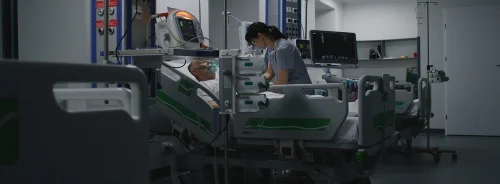In patients with severe acute respiratory distress syndrome (ARDS), managing gas exchange and avoiding ventilation-induced lung injury (VILI) are key challenges. Venovenous extracorporeal membrane oxygenation (ECMO) is used for severe ARDS with persistent hypoxaemia, effectively improving gas exchange and reducing ventilation pressures, though it doesn't support the cardiovascular system directly.
Recent evidence suggests that initiating ECMO might benefit the right ventricle by reducing pulmonary hypertension, which could be due to normalised blood gases and reduced ventilation. Higher mixed venous oxygen saturation (SvO2) from ECMO might also affect pulmonary circulation. Experimental studies have shown that ECMO can reverse hypoxic pulmonary vasoconstriction (HPV) and impact pulmonary arterial pressures (PAPs), but the outcomes are variable.
Blood flow rate in ECMO is crucial for determining SvO2, but there's significant variability in reported values. No prior studies have explored the direct effects of ECMO blood flow on SvO2 and its physiological impact. This study evaluates how different ECMO blood flow rates, targeted to specific SvO2 levels, influence pulmonary circulation, right ventricular workload, and ventilation-perfusion matching in severe ARDS patients.
In a study involving 20 patients, ECMO blood flows were adjusted to low (SvO2 target 70–75%), intermediate (SvO2 target 75–80%), and high (SvO2 target >80%) levels for 30 minutes each, in a randomised order. Mechanical ventilation settings remained constant throughout. The researchers assessed the haemodynamic and pulmonary effects using a pulmonary artery catheter and electrical impedance tomography.
As ECMO blood flow increased from low to high levels, cardiac output, mean pulmonary artery pressure and right ventricular stroke work index decreased. Specifically, cardiac output dropped from 9.2 to 7.9 L/min, mean pulmonary artery pressure decreased from 34 to 30 mm Hg, and right ventricular stroke work index fell from 14.2 to 11.4 g×m/beat/m². Cardiac output was inversely correlated with mixed venous and arterial Po₂ values, while pulmonary artery pressure correlated with decreasing mixed venous Po₂ and increasing cardiac output. There were no significant differences in ventilation-perfusion mismatch between the different ECMO flow levels.
Overall, these findings show that in patients with severe acute respiratory distress syndrome, increasing ECMO blood flow rate to achieve higher SvO2 levels reduces pulmonary artery pressure, cardiac output, and right heart workload.
Source: AJRCCM
Image Credit: iStock






